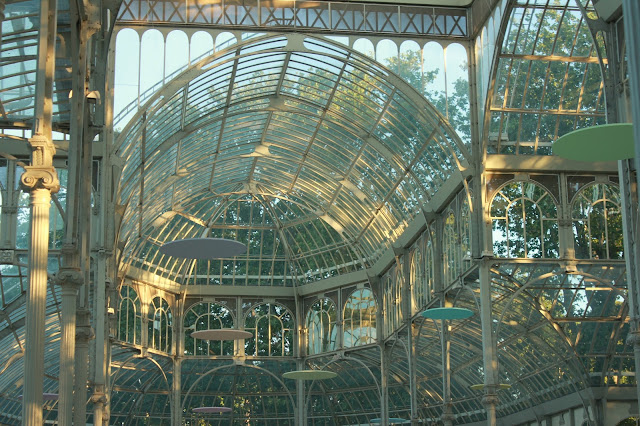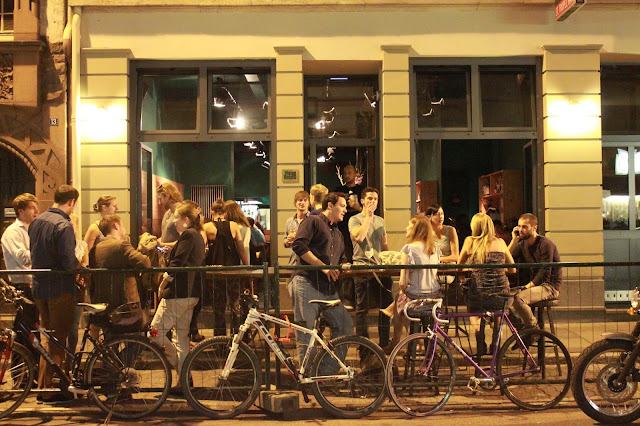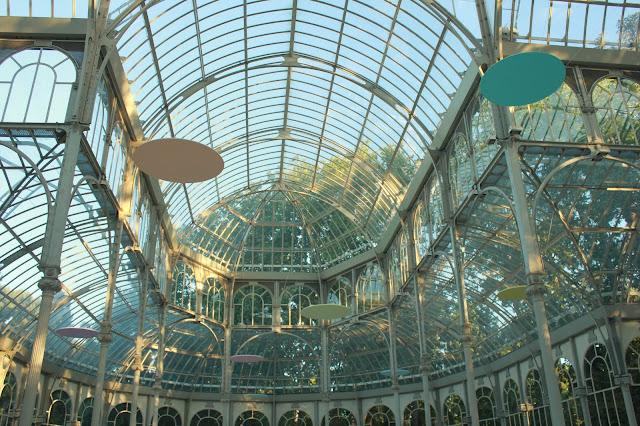Wednesday, 31 July 2013
Il postino
Back to the magnificent Teatro Real, which I last wrote about here, for the final opera of the season.
Daniel Catán's Il Postino is based on the film of the same name, a tribute to Chilean poet Pablo Neruda, one of my favourites. It tells the story of the poet’s spell living on a southern Italian island whilst in exile from Chile in the 1950s, and of his relationship with the villagers. He befriends the young postman and teaches him about love and poetry, all against a backdrop of post-war political uncertainty.
 |
| Projections of Neruda's scribbles of poetry |
The part of Pablo Neruda was written for Plácido Domingo, one of Madrid's most famous sons, who traditionally sings every year in the closing production of the Teatro Real's season. This year Domingo withdrew during rehearsals due to health reasons. The role is associated so strongly with him that the audience nearly revolted, but having never seen the opera before, or even the film, I went along with an open mind.
 |
| Vicente Ombuena steps in as Neruda (photo: Javier del Real) |
The staging was absolutely beautiful; covered in blue and white Mediterranean tiles, the stage often became the sea, a focus of Neruda's poetry whilst on the island. As the two main characters discuss or write poetry together, their words are projected onto the constantly changing backdrop, bringing it to life. The libretto is sung in Spanish; it's curiously pleasing to hear snippets of Neruda's poetry faithfully reproduced in his own language.
It had mixed reviews from the Madrid audience, almost entirely due to the lack of their favourite star. But the music was entrancing, it was sung beautifully and the performance was visually stunning: one of the best operas I've been to. Domingo or no Domingo.
Tuesday, 30 July 2013
Gute Nacht Frankfurt
The next instalment in The Year of the City Break was another weekend trip to Frankfurt, which I last wrote about here.
Being seasoned Frankfurters by now, we skipped the tourist sights and headed straight out for drinks. I arrived just in time to catch the last day of Opernplatzfest, the Opera Square Festival, a sprawl of buzzing food and drink stalls outside the beautiful Alte Oper, the old opera house.
Now that he's had a few months to settle in, Boyfriend has firmly decided on a favourite bar. Bar ohne Namen ("The Bar with No Name") is a tiny hole-in-the-wall which comes alive on hot summer evenings, when hordes of people spill out into the street clutching enormous gin and tonics and Aperol spritzes.
Frankfurt's Kleinmarkthalle is a bustling indoor market, a foodie's dream. On Saturday lunchtime we munched and sampled our way through the Moroccan, Turkish, German and Italian market stalls, before settling down to a glass of wine and some lunch on the sun deck.
 |  |
On Saturday night we skipped down to Walon & Rosetti, a hipster Italian restaurant, where we shared seriously salty lamb chops and melting tagliata steak, before spilling out into the street to join the crowds making the most of the summer heat.
 |  |

Just around the corner, nestled in the middle of the red light district, is "the off-licence" - not quite a bar, not quite an off-licence, where you can buy a beer or a can of whiskey and coke, pull up a plastic chair and hang out with the shop's resident DJ. With July temperatures up in the thirties, it was heaving.
 |  |
The next morning we were feeling somewhat delicate. Boyfriend's apartment is just around the corner from Frankfurt's Botanical Gardens, the Palmengarten. It's a beautiful place for a stroll, and even has a sprawl of sunloungers set out on the grass if you're feeling lazy.

 |  |
Being too scorching a day to explore the greenhouses, we made for the boating lake. Surrounded by willow trees, it's full of enormous carp, busy ducks and serenely floating swans.
 |  |
 |
| Making it look easy. |
 |  |
 |  |
And who said Frankfurt was just a financial centre?
Wednesday, 17 July 2013
Giacometti: terrenos de juego
Making the most of the two hour lunch break from work, last week I popped in to the Fundación Mapfre's current exhibition on Alberto Giacometti, one of my favourite sculptors. Giacometti: Terrenos de juego ("playing fields" or "game boards") focuses on the artist's interest in the concept of space, culminating in his famous large-scale sculptures for the Chase Manhattan Plaza Project, the Walking Man and Large Woman.
Spread over two floors, the exhibition begins with Giacometti's early surrealist sculptures and drawings, which were often designed to resemble the boards from board games, so that the space around the pieces was as important as the pieces themselves. These developed into plans for enormous public squares, where the observers are physically incorporated into the sculpture itself.
My favourite exhibits in the rooms of his earlier work were the series of black and white photographs taken of Giacometti in his studio by other artists, including Man Ray, Ernst Scheidegger and Henri Cartier-Bresson, which were beautiful pieces of art in their own right.
 |
| The Glade, 1950 |
Spread over two floors, the exhibition begins with Giacometti's early surrealist sculptures and drawings, which were often designed to resemble the boards from board games, so that the space around the pieces was as important as the pieces themselves. These developed into plans for enormous public squares, where the observers are physically incorporated into the sculpture itself.
My favourite exhibits in the rooms of his earlier work were the series of black and white photographs taken of Giacometti in his studio by other artists, including Man Ray, Ernst Scheidegger and Henri Cartier-Bresson, which were beautiful pieces of art in their own right.
The second floor showcases the groupings of stretched, fragile and coarse figures for which he is best known.
 |
| Three Men Walking, 1948 |
The exhibition focuses on the evolution of Giacometti's studio space alongside the drawings and sculptures, which was an interesting touch, even creating a representation of the tiny space by blowing up one of Giacometti's own drawings of his surroundings and wallpapering a room with it.
 |
| Large Woman II, 1960 |
The works gradually lead up to his most famous legacy: exploring how his idol-like nude sculptures of women culminated in the Large Woman, and how his portrait drawings and sculptures of his brother became the Male Head and the Walking Man.
They're free-standing on the gallery floor, allowing you to interact with them and making you notice the spaces between them, just as was originally intended.
| Walking Man I, 1960 |
Until 4 August 2013
Sunday, 14 July 2013
Diego Le Cigala
An unexpected change of plans for a colleague at work, and I was given two last minute tickets to see a flamenco singer I had never heard of. A quick google revealed how ignorant I was; Diego El Cigala is one of the most famous names in flamenco, not just in Spain but worldwide. He's the winner of two Grammy awards and has countless other nominations under his belt.
The concert, part of the Veranos de la Villa (Summer in the City) concert series, was completely sold out and swarming with television cameras. The audience was bristling with anticipation.
The music had so much more depth than I expected, combining elements of flamenco, jazz and tango. His voice is throaty yet smooth, somehow unmistakeably Spanish.
It wasn't long before the audience were on their feet, cheering the opening bars of each song, emotionally applauding the flamenco guitar and trumpet solos and calling for encore after encore. I'm a new flamenco convert.
Saturday, 13 July 2013
Memorias Imaginadas
One of my favourite buildings in Madrid is the Palacio de Cristal, a nineteenth-century iron and glass palace modelled after London's Crystal Palace.
Nestled in Parque del Retiro and adorned with ceramic tiles, it's now used as an exhibition space by the Museo Reina Sofía.
 |  |
Throughout the summer the Palacio has hosted the Japanese artist Mitsuo Miura's installation Memorias Imaginadas ("Imagined Memories").


Suspended coloured disks hang from the ceiling above partners of the same faded colour.
The effect creates invisible columns of space between the disks suspended from the ceiling and lying on the ground. It augments the feeling of space and, more simply, is just beautiful to look at.
The trees in the park outside and the sunlight streaming through the windows make it feel like the installation is a natural part of the world outside.

The exhibiton's blurb says that the spaces between the disks are intended to come to life with imagination and memory. The use of faded colours is supposed to suggest diffused, faded memories. Whether you buy into that reading or not, it's a beautiful stop off on a stroll through Retiro, and an atmospheric place to catch the sunset.
Until 2 September 2013
Subscribe to:
Comments (Atom)





























